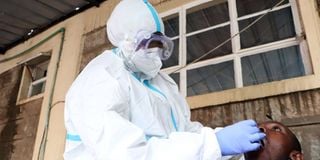Breaking: Autopsy reveals how Cyrus Jirongo died
Premium
Covid-19 infections firmly in rural communities, Kemri study shows

A health worker collects a swab sample from a resident in Kibera, Nairobi on Sunday, October 18, 2020 to test for Covid-19.
What you need to know:
- The coastal counties of Mombasa, Kwale and Kilifi remain hotspots even as normality returns and government officials start holding meetings in these regions.
Kwale had the highest jump in the Covid antibodies findings, increasing four-fold to 20.5 per cent in September from 5.1 in May.
Counties in Nyanza, Eastern, Rift Valley and North Eastern have joined Mombasa and Nairobi as Covid-19 hotspots, a Kenya Medical Research Institute (Kemri)-Wellcome Trust study shows.
This comes as the country is experiencing a second wave of infections.
Preliminary findings in antibody testing from several sources show that prevalence of exposure to SARS-CoV-2 has significantly increased, especially in Nairobi and Mombasa.
“The overall crude prevalence of antibodies to SARS-CoV-2 in blood donors was 5.6 per cent by May (3,098 samples) and this increased to 13.3 per cent by August 4, (3,651 samples),” the October findings read.
The coastal counties of Mombasa, Kwale and Kilifi remain hotspots even as normality returns and government officials start holding meetings in these regions.
The Coast has also seen a rise in the number of domestic tourists thronging beaches.
Covid antibodies
Kwale had the highest jump in the Covid antibodies findings, increasing four-fold to 20.5 per cent in September from 5.1 in May.
The county hosts pristine Diani beaches, one of the world’s top rated tourism attractions.
Kilifi saw its prevalence rise to 13.8 per cent in September, from 4.9 per cent.
For the Nairobi blood donors, crude antibody prevalence over the same period increased from 8.9 per cent to 21.5 per cent, and from 9.3 per cent to 17.1 per cent for Mombasa donors.
Central Kenya saw its prevalence increase from 6.7 per cent in May to 8.7 per cent in September, while Nyanza’s rose to 19.2 per cent from 6.5 per cent.
Eastern and Northern Eastern Kenya have seen the crude prevalence of antibodies to SARS-CoV-2 in blood donors jump from 2.1 per cent in May to nine per cent at the start of September.
Rift Valley – which is seeing counties like Nakuru, Kericho, Uasin Gishu and Turkana record high infections – covid antibody prevalence doubled to 10.2 per cent from 4.8 per cent in May.
Antenatal services
It also emerged that almost half of Kenyatta National Hospital (KNH) health care workers have been exposed to Covid-19, with almost a similar percentage of the women seeking antenatal services at the hospital.
“Antibody testing of residual blood samples from 196 mothers attending antenatal clinic visits at KNH suggests that 46.4 per cent have been exposed to SARS-CoV-2 at the time of sample collection between July 30 and August 25,” the study says.
The research adds that there is evidence of extensive spread of the disease, with the pandemic likely past its peak in Nairobi and central Mombasa.
“Recent modelling suggests the decline in the first epidemic period in September was largely in the main urban and surrounding semi-urban counties,” the researchers say.
“This is likely due to a reduction in the number of people in the population that is susceptible because a large proportion of the population (30-40 per cent) had already been infected. It was predicted that the epidemic would move to rural counties.”
Kemri says it is conducting antibody tests on an additional 3,397 blood donor samples, with an expected change in results.
“Rural and some urban sub-counties are contributing considerably more to the rise in cases,” the researchers said.





